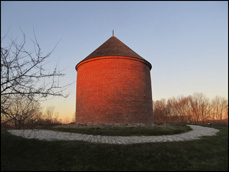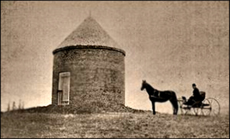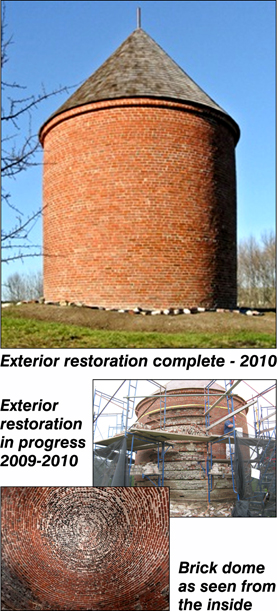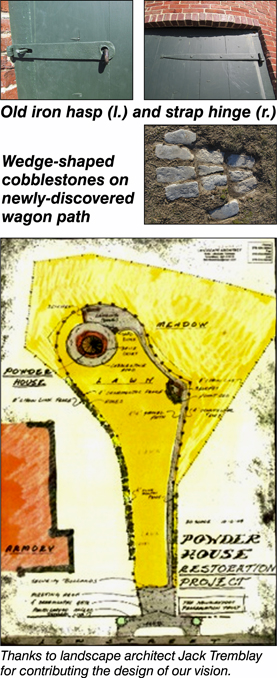-
-
-
-
-
-
-
POWDER HOUSE PARK & LEARNING CENTER
-
-
-
-
-
-
-
-
-
-
-
-

Powder House Park & Learning Center:
Award-winning restoration is only the beginning
 The spotlight continues to shine on our city's restored 1822 Powder House. Powder House Park & Learning Center, located on Godfrey's Hill off Low Street, Newburyport, opened in fall 2012 after nine years of planning, research, and restoration --- all supported by grants and generous donations. Since then, hundreds have visited at Essex Heritage Trails & Sails events, at Yankee Homecoming, and with school groups. In 2013 the Newburyport Preservation Trust’s efforts to preserve the long-neglected structure were recognized nationally with an Award of Merit from the American Association for State & Local History (AASLH). (Project co-chair Karen Holt of Newburyport, who has worked with co-chair Tom Kolterjahn on the project, accepted the award at a ceremony at the AASLH 2013 Annual Meeting in Birmingham, Alabama.)
The spotlight continues to shine on our city's restored 1822 Powder House. Powder House Park & Learning Center, located on Godfrey's Hill off Low Street, Newburyport, opened in fall 2012 after nine years of planning, research, and restoration --- all supported by grants and generous donations. Since then, hundreds have visited at Essex Heritage Trails & Sails events, at Yankee Homecoming, and with school groups. In 2013 the Newburyport Preservation Trust’s efforts to preserve the long-neglected structure were recognized nationally with an Award of Merit from the American Association for State & Local History (AASLH). (Project co-chair Karen Holt of Newburyport, who has worked with co-chair Tom Kolterjahn on the project, accepted the award at a ceremony at the AASLH 2013 Annual Meeting in Birmingham, Alabama.)
Although restoration of the building is complete, work has continued on the grounds, including (1) durable interpretive panels that tell the story of the Powder House, (2) a detailed survey of the original cobblestone wagon path, and (3) plans for the finishing touches of park landscaping. Ultimately the Powder House will serve Newburyport as a park and learning center for the edification of all. The public is welcome to visit and stroll Powder House Park during daylight hours between May and October.
To arrange a school group visit to the Powder House in the spring or fall, contact Tom Kolterjahn (978-462-8081, powderhouse@nbptpreservationtrust.org).
You can help the Powder House Park & Learning Center achieve its goals by donating either money or some of your time and skill. Send a check to NPT Powder House Fund, P. O. Box 184, Newburyport, MA 01950, or contact co-chairs Tom Kolterjahn (978-462-8081, powderhouse@nbptpreservationtrust.org) or Karen Holt (978-465-6212, karenholt1@comcast.net).
______________________________________________________________________
What is a Powder House? And why?: A bit of history
Why the need for a Powder House?  The c. 1822 Powder House --- located a safe distance from homes of the era --- stored gunpowder, flints, musket balls, and camp kettles used by the local militia to defend the community. The Powder House was built in the turbulent aftermath of the War of 1812, which saw Washington’s public buildings burned to the ground by the British. Every able-bodied male was required to join a militia. Newburyport’s Powder House was well-used during the Civil War. (Photo courtesy of Newburyport Archival Center)
The c. 1822 Powder House --- located a safe distance from homes of the era --- stored gunpowder, flints, musket balls, and camp kettles used by the local militia to defend the community. The Powder House was built in the turbulent aftermath of the War of 1812, which saw Washington’s public buildings burned to the ground by the British. Every able-bodied male was required to join a militia. Newburyport’s Powder House was well-used during the Civil War. (Photo courtesy of Newburyport Archival Center)
How did the Powder House survive until NPT's restoration?: The distinctive circular shape of the Powder House, and its location at the crest of Godrey's Hill off Low Street, made the building familiar to generations of Newburyporters. Yet because it was away from the downtown, and "off the beaten path," during the city's lowest ebb --- and even through brightest period of restoration --- the structure continued to deteriorate. At its worst it was open to the weather, vandals, and varmints. The building barely survived intact until NPT's restoration efforts, but the fact that it did is a familiar story in Newburyport: During the city's long period of economic malaise, it was not regarded as an asset of any value. And during the city's busiest years of rehabilitation, the Powder House was safely out of the path of downtown development.
NPT's years of restoration work, however, moved architectural historians to sit up an take notice. In fall 2013 Newburyport's 1822 Powder House was chosen as the subject of a Historic American Buildings Survey (HABS), with the resulting documentation taking its place among surveys of America's architectural heritage at the U.S. Library of Congress. Over the course of a year, students from Boston Architectural College documented the Powder House through measured drawings, photo studies, and historic research reports. Johanna Rowley of the BAC faculty directed the student team and managed the project. The completed survey remains a contender for the Charles E. Peterson Prize, which recognizes student excellence in measured drawings created to HABS standards. (Charles E. Peterson (1906-2004), conceived the HABS program in 1933, and is regarded as the founding father of the preservation architecture profession.)
______________________________________________________________________
A look back at over a decade of restoration efforts
 Restoration of the crumbling, long-neglected Powder House. In 2003, a group of citizens formed a restoration committee to preserve this important part of Newburyport’s history and open it to the public as a park and learning center. After years of researching original maps, historical documents, news articles, and images of other existing local powder houses, the committee began restoration work in 2009.
Restoration of the crumbling, long-neglected Powder House. In 2003, a group of citizens formed a restoration committee to preserve this important part of Newburyport’s history and open it to the public as a park and learning center. After years of researching original maps, historical documents, news articles, and images of other existing local powder houses, the committee began restoration work in 2009.
As seen in the photo at right, almost the entire front outer course of the Powder House was rebuilt, with as many original bricks as possible, using lime mortar. Other areas were re-pointed. Hundreds of wood shingles were hand-planed to conform to the shape of the curved roof, and a new copper finial for the roof top was replaced.
After careful study of late 19th-century photos of the Powder House, an accurate entrance was constructed. The new white oak door frame and hand-chiseled curved granite threshold are now securely in place, thanks to a gallant effort by Joe Napolitano of NAPCO. The batten door replica "clinched" together with wrought-iron nails was made from Spanish cedar for durability. The two photos of the door at right show the early strap hinges and the old iron hasp in place to attach a lock.
 Another highlight of the restoration effort was the discovery of the original cobblestone path. The path was used by heavy wagons carrying barrels of gunpowder, lead shot, musket balls, and musket flints. A survey by Everett Chandler of Design Consultants, Inc., and Sam Paplin, field crew, mapped the position of each cobblestone. As a result, permission was granted by the Massachusetts Historical Commission to uncover the path for a more detailed survey.
Another highlight of the restoration effort was the discovery of the original cobblestone path. The path was used by heavy wagons carrying barrels of gunpowder, lead shot, musket balls, and musket flints. A survey by Everett Chandler of Design Consultants, Inc., and Sam Paplin, field crew, mapped the position of each cobblestone. As a result, permission was granted by the Massachusetts Historical Commission to uncover the path for a more detailed survey.
Interior restoration included structural repairs to brickwork. Broken and missing bricks were replaced, floor beam pockets re-opened, and damaging Portland cement was removed. Circular wooden nailing pads were added to walls to support the bricks in damaged areas.
Interior restoration included structural repairs to brickwork. Broken and missing bricks were replaced, floor beam pockets re-opened, and damaging Portland cement was removed. Circular wooden nailing pads were added to walls to support the bricks in damaged areas.
Today, as work on the finishing touches of the Powder House Park & Learning Center continues, you can still help by donating either money or some of your time and skill. Send a check to NPT Powder House Fund, P. O. Box 184, Newburyport, MA 01950, or contact co-chairs Tom Kolterjahn (978-462-8081, powderhouse@nbptpreservationtrust.org) or Karen Holt (978-465-6212, karenholt1@comcast.net).